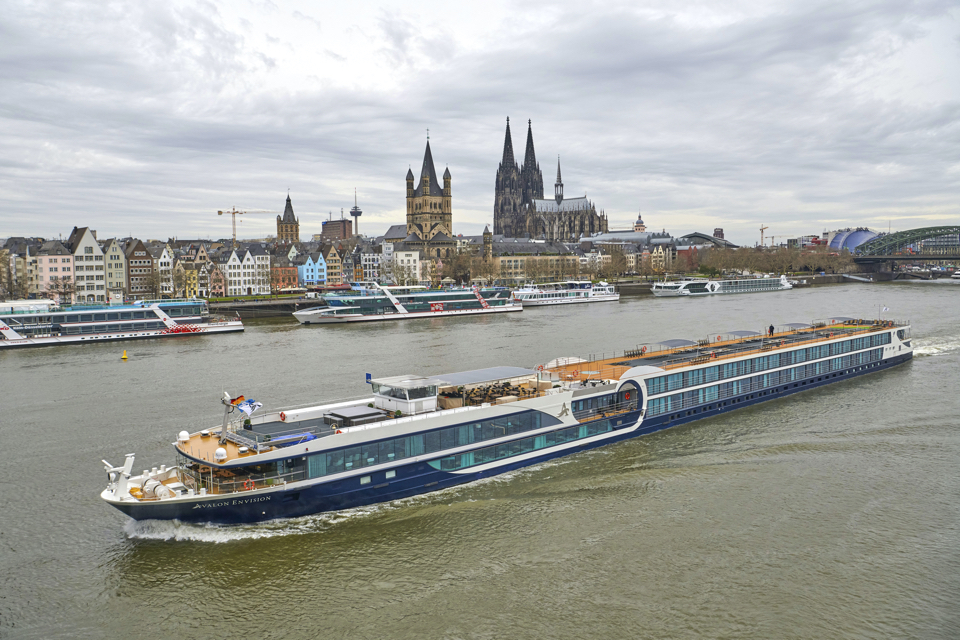In a relatively short amount of time, the river cruise industry has become an important money maker for Europe. In his latest opinion piece, SWZ|Maritime’s Editor-in-Chief Antoon Oosting draws a picture of this market segment and why it is so important to save it from the corona crisis.
It’s hard to imagine now, with all cruise ships, both ocean-going and those that sail on Europe’s biggest rivers, laid up in ports, anchor zones and along quays inland. But after every major crisis, be it a war or a financial one, the tourism industry recovered stronger than ever before. And although the world will never again be as before the corona crisis, our wanderlust will not die out that easy, as history has shown time and again.
And although owners and crews of the cruise industry will have a tough time, the industry was until recently very healthy financially. Unlike in the sixties and seventies, when the ships in river cruising were mainly family owned, today it is the playing field of internationally orientated, financially strong parties.
Last year, the turnover of travels by river cruise vessels in Germany alone amounted to € 653 million. The total amount of passengers on all the European rivers combined grew to 1.79 million, according to InteressenGemeinschaft (IG) RiverCruise, the Association of leading European River Cruise Companies.
According to its website, IG RiverCruise initially was a loosely organised community of shared interests founded in 2000 by three Swiss shipping companies. Aim was to represent the interests of river cruise shipping companies. Now, IG RiverCruise has become a registered association with headquarters in Basle representing over 239 ships (seventy per cent of the European market).
The total amount of passengers on all the European rivers combined grew to 1.79 million
As well as representing the members’ common, fundamental interests and concerns relevant for river cruises towards third parties, the organisation also sees itself as a contact and representative of the European river cruise sector.
The early Rhine cruises
Other tasks include the promotion and development of the image of the river cruise sector taking into special account the topics of training, safety and environmental protection and keeping in contact with organisations, institutions, and (umbrella) associations closely related to the sector. Sounds serious for a kind of tourism that has only quite recently seen a strong growth.
It began in the sixties when mostly the pre or early pensioners of the Netherlands and Germany enjoyed their first foreign holiday in the form of a voyage on the river Rhine and Moselle. Yet, soon tourism with cheap charter flights to the Mediterranean developed. The younger generations of the seventies and eighties considered “Een reisje langs de Rijn” (a trip along the Rhine), a song by Louis and Rika Davids from 1906, as a somewhat corny kind of tourism.
For quite long, it remained a kind of tourism specially focused on the elderly in which youngsters had no interest. And yet this kind of slow tourism would experience an enormous breakthrough from the late nineties and especially the last two decades.
In 1995, there were 50 river cruise ships in operation, compared to 300 today
Truly internationalised
In a position paper on the situation of the Western European river cruise world, IG RiverCruise wrote that from the opening of the Main-Danube-canal in 1992, river cruise tourism in Europe experienced a real boom. From then, the biggest ships with a length of up to 135 metres could sail from Amsterdam/Rotterdam to the Black Sea. In 1995, just 50 ships were in operation, compared to 300 today!
Ships sail from Amsterdam through the Netherlands, Germany, Austria, Slovakia and Hungary to Budapest. With 36.7 per cent, the Americans and Canadians are by far the biggest group of passengers, followed by the Germans (28.3 per cent), guests from the UK and Ireland (11.8 per cent) and those from Australia and New Zealand (7.5 per cent). The Dutch and Belgians probably still cannot rid themselves of the melody of “Een reisje langs de Rijn” and lag behind with just 1.1 per cent.
With the opening of the Main-Danube-canal, former Warsaw-pact countries such as Slovakia, Hungary, Romania and Bulgaria or former Yugoslav-republic Serbia and further on the ports and seaside resorts on the Black Sea can now be reached by river cruises.
The Dutch and Belgians lag behind with just 1.1 per cent
River cruises are also not restricted to just the Rhine and Danube anymore. Recent years also saw a strong development of river cruises on the main French rivers such as the Seine, Rhône, Saône, Garonne and Loire. Operators of river cruises even have their ships transported to the bigger rivers in Portugal or Italy on the Po and towards Venice. And not to forget Russia, which also has a reputable form of river cruise industry.
The most popular
This interest in making trips on the other rivers besides the Rhine, is also shown in IG RiverCruise’s market research. Looking at the Germans with a share of 37.1 per cent in 2019, the Rhine and its tributaries like the Main, Neckar and Mosel are still the most popular area. With 34.5 per cent, the Danube is the second most popular river, but the French rivers are gaining popularity with a share of 13.1 per cent.
Other European river zones (East and South Europe) attracted 6.9 per cent of the guests last year, a growth from 5.1 per cent in 2018, and a doubling over past few years. Rivers on other continents, for example in North and South America and Asia (especially China), attracted 6.1 per cent of German river cruise passengers.
The most important barrier for its development is the lack of infrastructure
The development of river cruising seems to follow cruising at sea where after developing the home markets, the Caribbean and Alaska for the Americans and Mediterranean and North Sea/Baltic for the Europeans, tourists now look to South America, the Middle East and Asia/Australia and Antarctica. And just like for ocean cruising, the most important barrier for its development is the lack of infrastructure in ports and suppliers, which of course is developing faster in Asia than in Africa.
Price is not a limiting factor anymore. With an average cost of € 1200 per person per trip, river cruising seems to be within reach of a big part of the consumers from Europe, North America, Asia and Australia.
More tourists need more ships
And although the Dutch tourist market might not be all that interested in taking a river cruise, building the ships required has peaked interest. Several Dutch shipyards, Den Breejen Shipyard in Hardinxveld-Giessendam, De Hoop Lobith, TeamCo Shipyard in Heusden en Vahali Shipyards in Gendt in particular, are strongly involved in building such ships. Most important competitor for the Dutch yards is the Neptun Werft in Warnemünde.
Especially at the beginning of the last decade, a lot of newbuilds entered the market: 16 in 2012; 22 in 2013, 31 in 2014, 27 in 2015, 22 in 2016, 18 in 2017, 10 in 2018; 18 in 2019 and another 19 are expected to be delivered in this year, according to data from IG RiverCruise.
The image of a dynamic, flourishing industry over the last decade in particular is also supported by data from the Central Commission for the Navigation of the Rhine (CCNR) in its 2019 European Inland Navigation Market Observation report. This report is the result of a successful and steadily improved collaboration with the European Commission.
 Picture by Hans de Wilde (SWZ|Maritime April 2020).
Picture by Hans de Wilde (SWZ|Maritime April 2020).
The 2019 report contains the 2018 data, with the 2019 data expected during the second quarter of this year, so too late for the April edition of SWZ|Maritime. Still, those 2018 data give a good impression of the industry. The most important conclusions are:
- The fleet of river cruise vessels in Europe in 2018 amounted to 359 active vessels, including 10 new and 3 modernised vessels that were introduced into the market in 2018. For 2019, 20 new vessels were expected to join the fleet.
- Over the last twelve years, the river cruise fleets in smaller river cruise regions not connected to the Rhine or the Danube, such as the Rhône-Saône, Seine and Douro, have expanded and sometimes more than doubled.
- River cruises have been experiencing a boom since 2013, mainly due to the large number of American tourists booking river cruise holidays. In 2018, there was an increase of 14.6 per cent, compared to 2017, reaching a total of 1.64 million river cruise passengers.
- For the first time, the annual report also contains information on the fleet of small river cruise vessels (with 10 to 39 beds) navigating Europe. This fleet is composed of 67 vessels, the majority of which are more than fifty years old. Main regions of operation are the Netherlands and France.
River cruises have been experiencing a boom since 2013
Growing and spreading
As can be expected, the fleet for river cruises in the EU region is mainly concentrated on central European waterways of Rhine/Main/Danube/Elbe/Oder. In 2018, the number of active river cruise vessels in this area represented close to 75 per cent of the total river cruise fleet in the EU.
The greatest concentration can be observed on the Rhine/Main/Main- Danube Canal/Danube area, with 253 vessels, including 35 on the Netherlands-Rhine axis. Despite the fact that all other European rivers not connected to the Rhine or the Danube are smaller cruising regions, their fleet has been expanding in the last decade, as follows:
- Rhône-Saône: 22 vessels in 2018 compared to 10 in 2006;
- Seine: 20 vessels in 2018 compared to 5 in 2006; and
- Douro: 20 vessels in 2018 compared to 6 in 2006.
With the total of 359 ships that where active in 2018, the river cruise industry reached a capacity of 52,078 beds. So to not let this dynamic industry languish, it is extremely important to overcome the current corona crisis.
Picture (top): The Avalon Envision was built by Den Breejen Shipyard and is the newest addition to the 2019 Avalon Suite Ship fleet.








